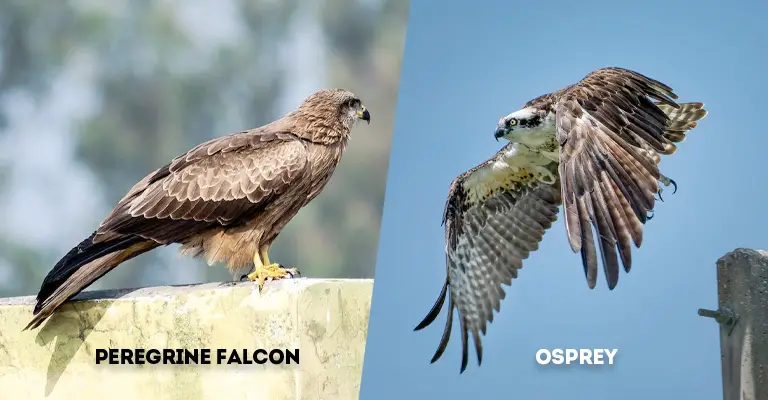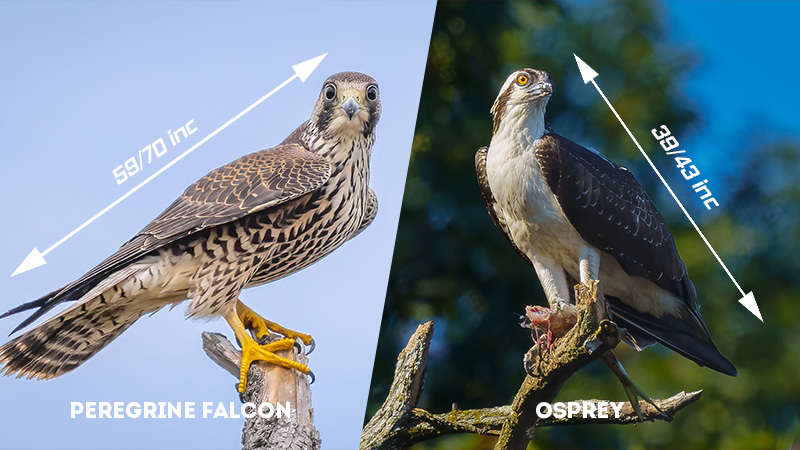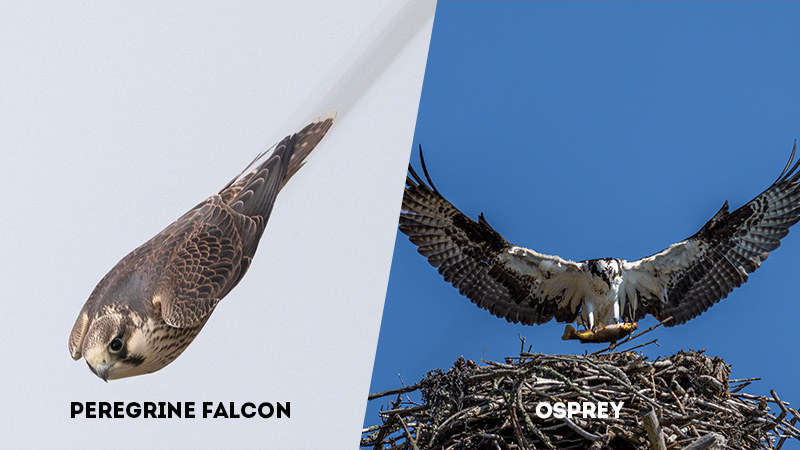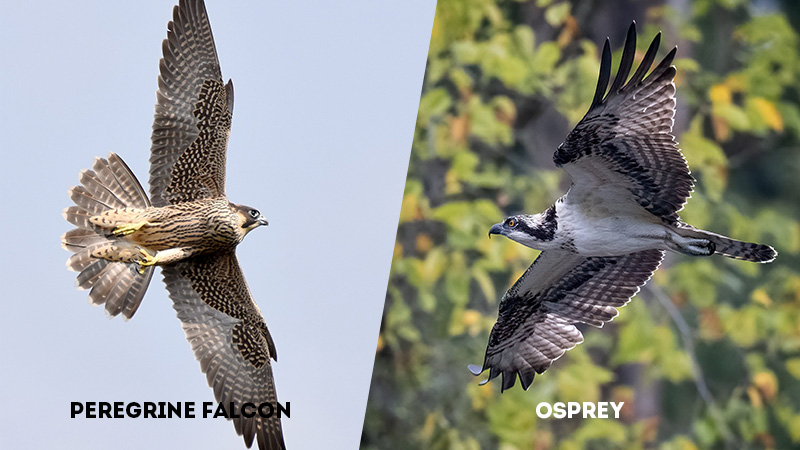Peregrine Falcons and Ospreys, two captivating species of birds of prey, exhibit distinctive characteristics that set them apart in the avian world.
From their hunting strategies to nesting preferences, these raptors showcase remarkable adaptations to their respective environments.
The Peregrine Falcon’s unrivaled speed during hunting dives and the Osprey’s adeptness at fishing are just glimpses into their unique lifestyles.
As we delve into the nuances of their behaviors, habitats, and conservation statuses, we unravel a deeper understanding of the diverse ways in which these birds navigate their ecosystems and interact with the world around them.

Key Differences Between Peregrine Falcon and Osprey
Peregrine falcons and ospreys are both raptors, but they have several key differences:
Size

- Peregrine Falcon: Peregrine Falcons exhibit a smaller and more compact build. With a wingspan ranging from 39 to 43 inches (100-110 cm) and a body length of 14 to 19 inches (36-48 cm), they are built for agility during high-speed dives.
- Osprey: In contrast, Ospreys boasts a larger and more robust physique. They possess a wingspan of about 59 to 70 inches (150-178 cm) and a body length of 21 to 24 inches (53-61 cm).
This adaptation suits their fishing lifestyle, enabling them to carry and maneuver with their aquatic prey effectively.
Speed
- Peregrine Falcon: Peregrine Falcons are renowned as the fastest animals on Earth. They can achieve remarkable speeds exceeding 240 miles per hour (386 km/h) during their characteristic hunting stoops. This incredible speed allows them to swiftly pursue and capture their avian prey in mid-air.
- Osprey: In contrast, Ospreys are not known for their speed like the Peregrine Falcons. While they are skilled hunters, their focus lies in a different realm.
Ospreys exhibit a more moderate pace during their hunting endeavors, primarily due to their specialization in catching fish.
Habitat
- Peregrine Falcon: Peregrine Falcons exhibit a versatile habitat range. They can be found across various environments, including cliffs, rocky landscapes, urban areas, and even tall buildings. These adaptable birds of prey have managed to carve out niches in both natural and human-made habitats.
- Osprey: Ospreys have a strong affinity for aquatic environments. They are commonly found near large bodies of water, such as coastal regions, lakes, and rivers.
This habitat choice aligns with their primary source of sustenance—fish. Ospreys are well-equipped to spot and catch fish while navigating these water-rich ecosystems.
Nesting
- Peregrine Falcon: Peregrine Falcons are known for their nesting preferences in elevated locations. They often choose high places like cliffs, tall buildings, and ledges for their nests. This choice provides safety and a strategic vantage point for hunting.
- Osprey: Ospreys exhibit distinct nesting behaviors that align with their aquatic lifestyle. They construct their nests close to water bodies, usually on platforms, trees, or man-made structures near the shoreline.
This proximity to water allows them to access their primary food source and provides an ideal environment for raising their young.
Feeding
- Peregrine Falcon: Peregrine Falcons are expert aerial hunters, preying on a variety of avian species. They use their speed and agility to engage in rapid mid-air chases and stoops, targeting birds such as pigeons, ducks, and smaller species.
- Osprey: Ospreys are specialized fish hunters. They have evolved with adaptations like reversible outer toe scales that aid in gripping slippery fish.
Ospreys hover above water bodies before diving down to catch fish near the surface with their powerful talons. Their diet consists predominantly of fish, making their habitat choice near water sources crucial for their survival.
Appearance
- Peregrine Falcon: The Peregrine Falcon boasts a distinctive appearance characterized by bluish-gray feathers on its upperparts and a white or cream-colored underside with fine barring.
This camouflage aids in blending with the sky and surroundings during its high-speed hunting dives. Their strong and compact build reflects their agility and prowess in the air. - Osprey: In contrast, the Osprey presents a specialized appearance suitable for its fish-hunting lifestyle. It features a white head, a dark eyestripe, and a brown back. This unique plumage aids in identifying its presence near water bodies.
Ospreys are larger and more robust than falcons, reflecting their adaptation for gripping and carrying fish.
Hunting Dive

- Peregrine Falcon: Peregrine Falcons are renowned for their breathtaking hunting dives, known as stoops. During these stoops, they utilize their exceptional speed to engage in rapid pursuits of their avian prey.
With remarkable precision, they strike their prey mid-air, using their powerful talons to secure their catch. - Osprey: Ospreys showcase a different hunting technique that befits their aquatic habitat. Rather than engaging in high-speed stoops, they employ a calculated dive towards the water’s surface.
This diving approach allows them to seize fish near the water, utilizing their sharp talons to grasp slippery prey effectively.
Primary Prey
- Peregrine Falcon: The primary diet of Peregrine Falcons consists of avian species, including pigeons, smaller birds, and ducks.
Their hunting strategy involves pursuing these birds in flight and catching them mid-air. Their impressive speed and agility aid in this avian pursuit. - Osprey: Ospreys are specialized fish hunters, focusing predominantly on fish species as their main source of sustenance.
They hover over water bodies, using their excellent eyesight to spot fish swimming near the surface. When they locate a suitable target, they dive headfirst, using their talon adaptations to secure the fish from the water.
Flight Style

- Peregrine Falcon: Peregrine Falcons exhibit agile and rapid flight maneuvers. Their wings are designed for high-speed pursuits and tight turns, enabling them to navigate through the air with remarkable precision. This flight style complements their hunting approach, allowing them to chase down fast-flying avian prey.
- Osprey: The flight style of Ospreys differs from that of Falcons due to their focus on fishing. They showcase a graceful flight with a unique hovering ability.
This hovering allows them to stay suspended in mid-air as they assess the water below for potential fish targets. Once they spot suitable prey, they execute their characteristic diving technique.
Talon Adaptations
- Peregrine Falcon: Peregrine Falcons possess powerful talons that are well-suited for gripping and immobilizing their avian prey.
These talons play a crucial role in securing their catch during mid-air strikes. Their hunting success heavily relies on these sharp and precise tools. - Osprey: Ospreys have developed specialized talon adaptations for their fish-centric hunting approach. They feature reversible outer toe scales that enhance their ability to grip slippery fish. This unique adaptation ensures that their prey remains secure during their dive and ascent from the water.
Speed in Hunting
- Peregrine Falcon: The Peregrine Falcon’s speed in hunting is unparalleled. It holds the title of the fastest animal on Earth, capable of reaching speeds exceeding 240 miles per hour (386 km/h) during its hunting dives.
This extraordinary speed enables it to swiftly close the gap between itself and its avian prey, making its hunting pursuits both dynamic and efficient. - Osprey: While not matching the Peregrine Falcon’s speed, the Osprey displays a different kind of precision in hunting.
It focuses on slower but calculated dives when hunting fish. This technique allows the Osprey to spot and catch fish near the water’s surface, capitalizing on its exceptional vision and powerful talons.
Diet
- Peregrine Falcon: Peregrine Falcons predominantly prey on avian species, including pigeons, doves, small birds, and even waterfowl.
Their diet consists of birds that they catch mid-air during high-speed chases, utilizing their agility, speed, and sharp talons. - Osprey: The Osprey’s diet centers around fish, earning it the nickname “fish hawk.” Fish make up the vast majority of their food intake.
Ospreys employ their unique hovering ability to locate fish swimming near the water’s surface. Once a suitable prey is identified, they dive into the water to capture it.
Coloration
- Peregrine Falcon: Peregrine Falcons have a distinctive coloration that aids in their hunting strategy. Their bluish-gray upperparts and white or cream-colored underside, marked with fine barring, provide effective camouflage against the sky and natural surroundings. This helps them surprise their avian prey during high-speed stoops.
- Osprey: Ospreys features a striking white head, dark eyestripe, and brown back. This coloration is well-suited for their aquatic lifestyle, allowing them to blend with the water and shoreline. Their appearance complements their hunting approach of catching fish near the water’s surface.
Territorial Behavior
- Peregrine Falcon: Peregrine Falcons are highly territorial when it comes to nesting sites. They fiercely defend their chosen cliffs, ledges, or urban structures where they build their nests. This territorial behavior is essential for ensuring the safety and success of their breeding efforts.
- Osprey: Ospreys exhibit territorial behavior as well, but their focus is often on their fishing territory rather than nesting sites.
They guard their chosen fishing spots vigorously, ensuring they have access to sufficient prey resources to sustain themselves and their offspring.
Migration
- Peregrine Falcon: Migration patterns of Peregrine Falcons can vary based on populations and regions. Some Peregrine Falcon populations are migratory, covering vast distances during their annual migrations to find suitable breeding and feeding grounds.
- Osprey: Ospreys are known for their extensive migratory behaviors. Many Osprey populations are migratory, traveling long distances between their breeding and wintering habitats. They follow specific migration routes, often along coastlines and water bodies, to ensure access to their preferred fish-rich environments.
Nesting Sites
- Peregrine Falcon: Peregrine Falcons exhibit a preference for elevated nesting sites. They choose locations like cliffs, tall buildings, and ledges for their nests. These elevated sites provide safety, protection, and a strategic vantage point for hunting.
- Osprey: Ospreys opt for nesting sites near water bodies. They often build their nests on platforms, trees, or man-made structures close to the shoreline. This proximity to water is crucial for easy access to fish, which constitutes their primary diet.
Eyesight

- Peregrine Falcon: Peregrine Falcons possess exceptional eyesight, which aids them in spotting their avian prey from great distances. Their keen vision allows them to identify small movements and details, enabling precise targeting during their high-speed hunting dives.
- Osprey: Ospreys also have remarkable eyesight, but their focus is primarily on spotting fish in aquatic environments. Their vision is adapted to locating fish near the water’s surface, allowing them to accurately assess the movements of potential prey.
Vocalizations
- Peregrine Falcon: Peregrine Falcons are known for their vocalizations, which include high-pitched calls and shrill cries.
These calls serve various purposes, including communication between mates, defending territories, and announcing their presence to other birds. - Osprey: Ospreys communicate through a range of vocalizations that include whistles, calls, and chirps. These sounds are used for territorial displays, attracting mates, and interactions within the family group.
Global Distribution
- Peregrine Falcon: Peregrine Falcons have a global distribution, found on every continent except Antarctica. They inhabit a diverse range of habitats, from urban areas to remote wilderness, showcasing their adaptability.
- Osprey: Ospreys also have a global distribution, spanning across various regions around the world. They are widespread in both freshwater and marine environments, indicating their ability to thrive in diverse ecosystems.
Conservation Status
- Peregrine Falcon: The conservation status of Peregrine Falcons varies among populations. While some populations have recovered well from declines linked to pesticide use, others remain endangered in specific regions. Conservation efforts have played a significant role in restoring their numbers.
- Osprey: Generally, Osprey populations are in better conservation status than many other raptor species. They are not as critically threatened and are often considered of “Least Concern” globally. However, local populations can face challenges due to habitat loss and human disturbances
Peregrine Falcon vs. Osprey: Comparison Table
| Aspect | Peregrine Falcon | Osprey |
|---|---|---|
| Size | Smaller and compact build | Larger and more robust physique |
| Speed | Fastest animal; speeds over 240 mph | Slower compared to falcons |
| Habitat | Various environments; cliffs, urban areas | Near large bodies of water; coasts, lakes |
| Nesting | Cliffs, tall buildings | Near water bodies; use nests or platforms |
| Feeding | Hunts birds in mid-air | Specialized fish hunter |
| Appearance | Bluish-gray upperparts, white underside | White head, brown back, dark eyestripe |
| Hunting Dive | Spectacular stoops to catch birds | Dives to catch fish from water surface |
| Primary Prey | Avian prey like pigeons, smaller birds | Fish, mainly caught from water |
| Flight Style | Agile, quick maneuvers | Graceful flight with hovering ability |
| Talon Adaptations | Powerful talons for bird strikes | Reversible talon scales for fish grip |
| Speed in Hunting | Rapid pursuit during dives | Precision diving for fish capture |
| Diet | Varied avian species | Primarily fish-based diet |
| Coloration | Blended bluish-gray and white feathers | White head, dark eyestripe, brown back |
| Territorial Behavior | Defends nesting sites fiercely | Defends fishing territory vigorously |
| Migration | Some populations migrate | Migratory behavior common |
| Nesting Sites | Cliffs, ledges, urban structures | Nests near water on platforms or trees |
| Eyesight | Exceptional visual acuity | Excellent vision for spotting fish |
| Vocalizations | Shrill calls and vocalizations | Whistles, calls, and chirps |
| Global Distribution | Found on every continent except Antarctica | Found globally, excluding Antarctica |
| Conservation Status | Varies; some populations endangered | Generally secure; varying statuses |
Frequently Asked Questions
The Peregrine Falcon’s high-speed hunting dives, or stoops, are primarily driven by its need to catch avian prey in mid-air. Its exceptional speed exceeding 240 miles per hour (386 km/h) allows it to close the gap rapidly and strike with precision.
The Osprey’s reversible talon adaptation involves specialized scales on its outer toes. These scales can move backward, creating a larger surface area to grip slippery fish effectively. This adaptation ensures that its aquatic prey remains secure during its dive and ascent from the water.
Peregrine Falcons’ vocalizations, including high-pitched calls and cries, serve various purposes like communication, territory defense, and mate attraction. Ospreys use whistles, calls, and chirps to communicate within their family groups and establish territorial displays.
Ospreys are known for their extensive migratory behavior. They follow specific migration routes along coastlines and water bodies, which provide them access to fish-rich environments. Their migration allows them to ensure a steady supply of food throughout the year.
While some populations of Peregrine Falcons have made remarkable recoveries from the declines caused by pesticide use, certain regions still see lingering effects. Efforts to ban and regulate harmful pesticides have contributed to the species’ rebound in many areas, but ongoing monitoring is crucial for their continued conservation.
To Recap
The Peregrine Falcon and Osprey exemplify nature’s diversity in avian adaptations. While the Falcon’s aerial prowess and rapid stoops demonstrate a mastery of mid-air hunting, the Osprey’s ability to hover and catch fish from water’s edge showcases its specialization in aquatic environments.
Their distinct nesting behaviors, eyesight, vocalizations, and global distributions add layers to their uniqueness. With conservation efforts playing a pivotal role in their survival, these magnificent birds serve as testament to the delicate balance of ecosystems.
Studying their differences enriches our understanding of the natural world’s intricacies and the intricate interplay of life within it.